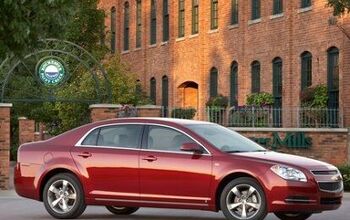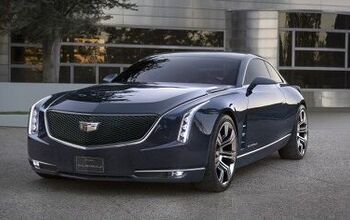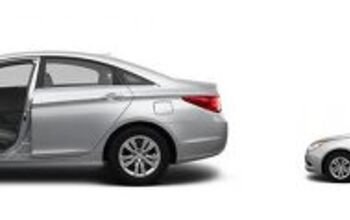GM Will Build Less To Make More

“In attempts to boost profitability, GM wants to cut the number of vehicle platforms by half over the next decade and consolidate the number of engines,” reports the DetN. That’s the good news. The bad news is that “GM’s executives admit the automaker continues to have an inefficient manufacturing network, weak supplier relations and too many variations in the types of engines and vehicle underpinnings it uses to build cars and trucks globally.” If the DetN says it, then it must be true. Putting platforms and engines on a diet is seen as the cure.
Mary Barra, GM’s product chief, told the DetN and an assemblage of Wall Street analysts that by 2018, “GM hopes to build 90 percent of its vehicles on 14 platforms — half the number now — and boost manufacturing efficiency by 40 percent.” Not to nitpick, but if you build 90 percent of your vehicles on 14 platforms, then you can’t build the remaining 10 percent on thin air and you will need more platforms for low volume cars. So we talked a bit to GM to find out more about how they will go from zaftig to svelte.
The basic story is that GM is trying to streamline its “too many variations in the types of engines and vehicle underpinnings,” and this is a good thing.
Currently, only a third of GM’s volume comes from cars that share what GM calls “core architectures.” The rest sits on a hodgepodge of what GM charitably calls “regional architectures.” Currently, there are 30 “Core Architectures” and an untold number of regional dishes.
In the future, GM’s local chefs will have to use a common cookbook. By 2014, in the world of cars that is tomorrow, the number of “Core Architectures” will shrink to 24, but the global volume that uses these core architectures will grow to 62 percent. Four years later, by 2018, all regional architectures will have vanished. The number of global architectures will have shrunk to 14. Those 14 global architectures will serve 90 percent of the volume.
But again, what about the remaining 10 percent? “There are a few cars that have a unique architecture, which they share with nobody,” explains Klaus-Peter Martin, GM spokesman in Detroit. As examples, he names the Chevrolet Corvette and some vehicles produced with GM’s JV partners in China.
Likewise, the number of engine platforms will shrink from currently around 20 to less than 10 in 2018. Keep in mind theses are engine platforms, which allow a multitude of engines.
GM expects global efficiency gains between 35 and 40 percent from this, which is a tall order. But if you look at how little global commonality there is currently in the world of GM, those numbers should be doable. With a lot of screaming from the natives.
Michelle Krebs of Edmunds says “it’s the course a lot of manufacturers are taking. Everyone is trying to get to greater economies of scale.”
Volkswagen for instance is moving away from platform-think and goes to its new kit architecture. This allows a much higher number of different cars with different character, built from modules. Object-oriented car design, if you will. On a smaller scale, BMW creates a number of engines, gasoline and diesel, from one building block, a single, standardized cylinder.
This industry takes huge investments, and spreading them across as many units as possible is the name of the game. If you make the most from the least, you win. Don’t think “badge engineering” when you hear this. If done right, the slimdown can make the offerings more attractive, and can help the brand(s) gain sex-appeal. That of course remains in the eye of the beholder. If you like the right lady, you’ll complain that the left one is the wrong one.

Bertel Schmitt comes back to journalism after taking a 35 year break in advertising and marketing. He ran and owned advertising agencies in Duesseldorf, Germany, and New York City. Volkswagen A.G. was Bertel's most important corporate account. Schmitt's advertising and marketing career touched many corners of the industry with a special focus on automotive products and services. Since 2004, he lives in Japan and China with his wife <a href="http://www.tomokoandbertel.com"> Tomoko </a>. Bertel Schmitt is a founding board member of the <a href="http://www.offshoresuperseries.com"> Offshore Super Series </a>, an American offshore powerboat racing organization. He is co-owner of the racing team Typhoon.
More by Bertel Schmitt
Latest Car Reviews
Read moreLatest Product Reviews
Read moreRecent Comments
- W Conrad I'm not afraid of them, but they aren't needed for everyone or everywhere. Long haul and highway driving sure, but in the city, nope.
- Jalop1991 In a manner similar to PHEV being the correct answer, I declare RPVs to be the correct answer here.We're doing it with certain aircraft; why not with cars on the ground, using hardware and tools like Telsa's "FSD" or GM's "SuperCruise" as the base?Take the local Uber driver out of the car, and put him in a professional centralized environment from where he drives me around. The system and the individual car can have awareness as well as gates, but he's responsible for the driving.Put the tech into my car, and let me buy it as needed. I need someone else to drive me home; hit the button and voila, I've hired a driver for the moment. I don't want to drive 11 hours to my vacation spot; hire the remote pilot for that. When I get there, I have my car and he's still at his normal location, piloting cars for other people.The system would allow for driver rest period, like what's required for truckers, so I might end up with multiple people driving me to the coast. I don't care. And they don't have to be physically with me, therefore they can be way cheaper.Charge taxi-type per-mile rates. For long drives, offer per-trip rates. Offer subscriptions, including miles/hours. Whatever.(And for grins, dress the remote pilots all as Johnnie.)Start this out with big rigs. Take the trucker away from the long haul driving, and let him be there for emergencies and the short haul parts of the trip.And in a manner similar to PHEVs being discredited, I fully expect to be razzed for this brilliant idea (not unlike how Alan Kay wasn't recognized until many many years later for his Dynabook vision).
- B-BodyBuick84 Not afraid of AV's as I highly doubt they will ever be %100 viable for our roads. Stop-and-go downtown city or rush hour highway traffic? I can see that, but otherwise there's simply too many variables. Bad weather conditions, faded road lines or markings, reflective surfaces with glare, etc. There's also the issue of cultural norms. About a decade ago there was actually an online test called 'The Morality Machine' one could do online where you were in control of an AV and choose what action to take when a crash was inevitable. I think something like 2.5 million people across the world participated? For example, do you hit and most likely kill the elderly couple strolling across the crosswalk or crash the vehicle into a cement barrier and almost certainly cause the death of the vehicle occupants? What if it's a parent and child? In N. America 98% of people choose to hit the elderly couple and save themselves while in Asia, the exact opposite happened where 98% choose to hit the parent and child. Why? Cultural differences. Asia puts a lot of emphasis on respecting their elderly while N. America has a culture of 'save/ protect the children'. Are these AV's going to respect that culture? Is a VW Jetta or Buick Envision AV going to have different programming depending on whether it's sold in Canada or Taiwan? how's that going to effect legislation and legal battles when a crash inevitibly does happen? These are the true barriers to mass AV adoption, and in the 10 years since that test came out, there has been zero answers or progress on this matter. So no, I'm not afraid of AV's simply because with the exception of a few specific situations, most avenues are going to prove to be a dead-end for automakers.
- Mike Bradley Autonomous cars were developed in Silicon Valley. For new products there, the standard business plan is to put a barely-functioning product on the market right away and wait for the early-adopter customers to find the flaws. That's exactly what's happened. Detroit's plan is pretty much the opposite, but Detroit isn't developing this product. That's why dealers, for instance, haven't been trained in the cars.
- Dartman https://apnews.com/article/artificial-intelligence-fighter-jets-air-force-6a1100c96a73ca9b7f41cbd6a2753fdaAutonomous/Ai is here now. The question is implementation and acceptance.


































Comments
Join the conversation
Those posters who have mentioned GM selling different cars on the same platform in different markets. If your Buick drives like an Opel, will you care as long as you've never driven an Opel? Holdens that become Chevrolets (I pray.)
What took you so long?